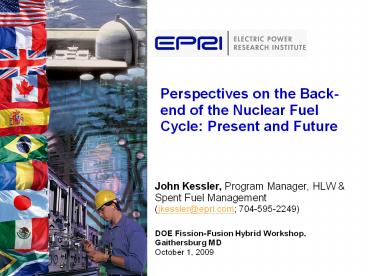Perspectives on the Back-end of the Nuclear Fuel Cycle: Present and Future - PowerPoint PPT Presentation
Title:
Perspectives on the Back-end of the Nuclear Fuel Cycle: Present and Future
Description:
John Kessler, Program Manager, HLW & Spent Fuel Management (jkessler_at_epri.com; 704-595-2249) DOE Fission-Fusion Hybrid Workshop, Gaithersburg MD – PowerPoint PPT presentation
Number of Views:188
Avg rating:3.0/5.0
Title: Perspectives on the Back-end of the Nuclear Fuel Cycle: Present and Future
1
Perspectives on the Back-end of the Nuclear Fuel
Cycle Present and Future
- John Kessler, Program Manager, HLW Spent Fuel
Management (jkessler_at_epri.com 704-595-2249) - DOE Fission-Fusion Hybrid Workshop, Gaithersburg
MDOctober 1, 2009
2
Projected US Commercial Spent Nuclear Fuel (CSNF)
Inventory (assumes all existing plants run for 60
years)
Current Yucca Mountain legal CSNF capacity limit
(63,000)
3
Dry Interim Storage High Burnup and Extended
Storage
EPRI data and models are the basis for
enabling Dry storage of spent fuel with burnup
gt45 GWd/MTU Dominion, Duke Energy,
Constellation, Dry storage license extended
from 20 to 60 years First license renewal Surry
site Conclusion Long(er)-term storage can give
us time to introduce new technologies
4
EPRI Yucca Mountain and Generic Disposal Program
- Yucca Mountain-specific
- Pre- and post-closure
- Transportation
- Generic disposal
- Compare post-closure doses from alternative fuel
cycle waste forms - Need for a second repository?
5
DOE Yucca Mountain Repository Design
6
DOE TSPA Results
- 10,000-year results
- Mean peak dose rate to the RMEI 0.2 mrem/yr
- 0.1 of background
- 1 of dose limit
- Dominated by (relatively) early failure of
DOE/Defense wastes - 1,000,000-year results
- Mean peak to RMEI 2 mrem/yr
- 1 of background
- 10 of dose limit
- Dominated by commercial spent nuclear fuel (CSNF)
7
EPRI TSPA Results (CSNF only)
- 0.04 mrem/y
- 0.01 of background
- 0.2 of dose limit
- 1/50th of DOE estimate
- Why are EPRI estimates lower?
- Reduction of conservatisms
EPRI, 2006, Report 1013444, Fig. 6-3
8
The Peak Dose is NOT Dominated by the Most
Radiotoxic Species
- The geology takes care of the more radiotoxic
species - Example relatively low solubility of many
actinides (including Pu) - Sorption on geologic media impedes many
radionuclides from movement - Conclusion inappropriate to use radiotoxicity
as a measure for potential technical improvements - Closing the fuel cycle
- Fission-fusion hybrids,
- Only a handful of radionuclides contribute to
long-term dose (not usually minor actinides)
9
Yucca Mountain Peak Dose Estimates Have Been
Decreasing. Why?
- Additional data
- Removal of initial conservatisms
- Improved (lower) Np solubility estimates
dramatically decreased importance of Np-237 - EPRI drip shield example (next slide)
10
Example of Over-conservatism Drip Shields are
not Necessary
What did DOE do to make it think it needed Drip
Shields?
- Overestimated the amount of net infiltration
- Overestimated the fraction of the repository
experiencing seepage into the open drifts - Overestimated seismic energy and rockfall
- Overestimated damage to the TADs due to seismic
and rockfall events - Overestimated the rate at which Alloy 22 will
degrade - Cladding performance was neglected
- Waste form alteration time was underestimated
11
Which is Cheaper, Faster, and Easier to Lower
Dose Estimates for Disposal
- Additional work to remove conservatisms in dose
estimates? - Drip shield example even saves money and time!
- Introduce a major technological fix (e.g.,
fission-fusion hybrids)?
12
Several Benefits of Making Yucca Mountain
Capacity Larger than the Current Legal Limit
- Nuclear industry interested in building new
plants - Opponents will point out there isnt enough
disposal space for existing plants - Delays or even eliminates the need for a second
repository - Provides sufficient time buffer for introduction
of advanced fuel cycles - RD time to get closed fuel cycles into
commercial operation 30-50 years
13
Yucca Mountain Capacity Options the EPRI Team
Analyzed
- Option 1 Expanded repository footprint
- Option2 Multi-level repository
- Option 3 Grouped, single-level emplacement
drifts - Determine the range in expansion factor
attributable to each option - Combinations of options
14
EPRI-Projected Yucca Mountain Technical Capacity
is Much Higher Than the Legal Limit
EPRIs projected technical capacity
range (260,000-570,000 MTU, 4 to 9 times current
legal limit)
Current legal limit (63,000 MTU)
15
Feasibility of Direct Disposal of Dual-Purpose
Canisters (DPCs, licensed for storage and
transportation only)
- Motivation
- Industry currently using DPCs
- Avoids need to repackage
- DPC capacity 1.5x DOEs Transportation, Aging,
and Disposal canisters (TADs) - Considerations
- DPC versus TAD diameter it still fits
- Added decay heat effects (hydrothermal,
thermomechanical) Yucca Mountain can handle it - Post-closure dose no effect
- Criticality still wont happen
16
Need for Advanced Fuel Cycles for Waste Disposal
Minimization? NO!
- Yucca Mountain doses are already very low (lt1 of
background) - True for all other repository system estimates
- Yucca Mountain technical capacity is big enough
for decades to come - Why trade off near-term, certain increase in dose
to lower very long-term hypothetical dose? - Need to compare source terms from the entire fuel
cycle not just what is headed to disposal - Which is cheaper and faster, introducing
fission-fusion hybrids or doing some more work to
eliminate conservatisms in disposal dose
estimates? - Radiotoxicity is an inappropriate measure
- Therefore, introduce advanced fuel cycle for
reasons other than reducing waste disposal needs - Economics, resource utilization, energy
independence,
17
Yucca Mountain (and Most Other Repository
Systems) can Help Keep our Options Open for
Decades to Come
- Use them as temporary storage until advanced fuel
cycle(s) are ready - Co-locate storage, reprocessing, fuel
fabrication, and disposal? - No need to move spent fuel twice if no nuclear
advancement - Conclusion Judicious use of repositories will
support realistically-paced advanced fuel cycle
development
18
TogetherShaping the Future of Electricity































